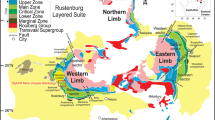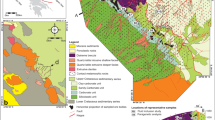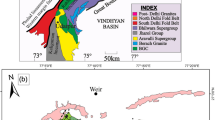Abstract
The paper reports data on the geological structure, mineralogy, and geochemistry of inner-contact syenites of the Late Paleozoic Khasurta quartz syenite-monzonite massif in western Transbaikalia. The rocks of the massif intrude Cambrian terrigenous-carbonate deposits transformed (depending on their composition) into apodolomitic magnesian spinel-fassaite skarns or plagioclase-quartz-biotite-cordierite hornfels that replaced amphibole-biotite schists. The skarn zone does not exceed a few dozen centimeters in thicknes. The inner-contact zone of the intrusion a few dozen meters thick consists of leucocratic medium-grained pyroxene syenites, which consist of coarsely perthitic K-Na feldspar (90–95 vol %) with plagioclase (An 40–46) cores, zonal clinopyroxene (up to 5–7 vol %), and sphene (up to 3–4 vol %). The inner-contact syenites differ from all other rocks of this massif in having the highest alkalinity and elevated concentrations of SiO2 and the lowest contents of CaO, MgO, and FeO. The mineralogical composition of the inner-contact syenites makes them similar to skarn-related metasomatic rocks (Korzhinskii, 1948), but the pyroxenes of these rocks contain melt inclusions homogenizing at 1100°C, a fact testifying to the magmatic genesis of the rocks. The results of our research indicate that the inner-contact syenites were formed with the assimilation of the host dolomites by the syenite melt. The enrichment of the inner-contact syenite melt in CaO and MgO and a significant increase in its liquidus temperature due to CO2 dissolution (Jahannes and Holtz, 1996) facilitated the crystallization of calcic plagioclase, pyroxene, and magnetite. The fractionation of these minerals resulted in the enrichment of the residual melt in SiO2 and alkalis, mostly K2O, and this subalkaline residual melt produced that K-Na feldspar, which is the predominant mineral of these rocks, and sphene. Excess CO2 drastically suppressed the H2O activity in the melt and thus hampered the crystallization of amphibole and biotite in the inner-contact zone of the intrusion. Mass-balance calculations indicate that dolomite assimilation was not very extensive and did not exceed 1: 10.
Similar content being viewed by others
References
S. M. Aleksandrov, Geochemistry of Skarn and Ore Formation in Dolomites (Nauka, Moscow, 1990) [in Russian].
V. S. Antipin, Geochemical Evolution of the Calc-Alkaline and Subalkaline Magmatism (Nauka, Novosibirsk, 1992) [in Russian].
C. W. Burnham, “Magmas and Hydrothermal Fluids,” in Geochemistry of Hydrothermal Ore Deposits, ed. by H. L. Barnes (Wiley, New York, 1979; Mir, Moscow, 1982), pp. 71–136 [in Russian].
R. A. Brooker, S. C. Kohn, J. R. Holloway, and P. F. McMillan, “Structural Controls on the Solubility of CO2 in Silicate Melts. Part II: IR Characteristics of Carbonate Groups in Silicate Glasses,” Chem. Geol. 174, 241–254 (2001).
I. V. Burdukov, A. A. Tsygankov, and T. T. Vrublevskaya, “Inner-Contact Syenites of the Khasurta Monzonite-Granosyenite Pluton: Magmatic Or Metasomatic Rocks?,” in Proceedings of the Interim IAGOD Conference on Metallogeny of the Northwest Pacific: Tectonics, Magmatism and Metallogeny of Active Continental Margins, Vladivostok, Russia, 2004 (Dalnauka, Vladivostok, 2004), pp. 184–187.
C. W. Burham and R. H. Jahns, “A Method for Determining the Solubility of Water in Silicate Melts,” Am. J. Sci. 260, 721–745 (1962).
N. L. Dobretsov, Yu. N. Kochkin, A. P. Krivenko, and V. A. Kutolin, Rock-Forming Pyroxenes (Nauka, Moscow, 1971) [in Russian].
M. B. Epel’baum, Silicate Melts with Volatiles (Nauka, Moscow, 1980) [in Russian].
G. B. Fershtater, “Empirical Plagioclase-Hornblende Barometer,” Geokhimiya, No. 3, 328–335 (1990).
F. Gaillard, B. Scaillet, M. Pichavant, and J.-M. Beny, “The Effect of Water and f o 2 on the Ferric-Ferrous Ratio of Silicic Melts,” Chem. Geol. 174, 255–273 (2001).
M. Gerard, B. Jacques-Marie, and M. J.-P. Rene, “Chemical Trends of Early-Formed Clinopyroxene Phenocrysts from Some Alkaline and Orogenic Basic Lavas,” Bull. Soc. Geol. Fr. 4, 851–859 (1988).
E. N. Gramenitskii, A. R. Kotel’nikova, A. M. Batanova, et al., Experimental and Technical Petrology (Nauchnyi Mir, Moscow, 2000) [in Russian].
E. N. Grib and V. L. Leonov, “Evolution of Magmatic Chambers of the Calderas in the Southern Sector of the Karymskii Volcanic Center. Part II. P-T-f Crystallization Conditions of Ignimbrite-Forming Melts and the Magmatic Evolution,” Vulkanol. Seismol., No. 5, 23–36 (2004).
T. Holland and J. Blundy, “Non-Ideal Interactions in Calcic Amphiboles and Their Bearing on Amphibole-Plagioclase Thermometry,” Contrib. Mineral. Petrol. 116(4), 433–447 (1994).
W. Johannes and F. Holtz, Petrogenesis and Experimental Petrology of Granitic Rocks (Springer, Berlin, 1996).
S. V. Kanakin and N. S. Karmanov, “An IBM Compatible Software Package for an MAR-3 and MAR-4 Microprobes,” in Proceedings of 3rd All-Russia and 6th Siberian Conference on X-ray Analysis, Irkutsk, 1998 (Irkutsk, 1998), p. 67 [in Russian].
N. S. Karmanov and S. V. Kanakin, “Modernization of a MAR-3 Microprobe,” in Proceedings of 3rd All-Russia and 6th Siberian Conference on X-ray Diffraction Analysis, Irkutsk, 1998 (Irkutsk, 1998), p. 24 [in Russian].
Classification and Nomenclature of Igneous Rocks (Nedra, Moscow, 1981) [in Russian].
D. S. Korzhinskii, “A Sketch of Metasomatic Processes,” in Principal Problems in the Study of Magmatic Ore Deposits (Akad. Nauk SSSR, Moscow, 1955), pp. 334–456 [in Russian].
D. S. Korzhinskii, “Petrology of the Tur’inskii Copper Skarn Deposit,” Tr. Inst. Geol. Nauk Akad. Nauk SSSR, No. 68, 148 (1948).
B. E. Leak, A. R. Woolley, C. E. S. Arps, et al., “Nomenclature of Amphiboles: Report of the Subcommittee on Amphiboles of the International Mineralogical Association Commission on New Minerals and Mineral Names,” Eur. J. Mineral. 9, 623–642 (1997).
F. A. Letnikov, V. Ya. Medvedev, and L. A. Ivanova, Interaction of Granitoid Melt with Carbonates and Silicates (Nauka, Novosibirsk, 1978) [in Russian].
B. A. Litvinovskii, A. N. Zanvilevich, A. M. Alakshin, and Yu. Yu. Podladchikov, Angara-Vitim Batholith: The Largest Granitoid Pluton (OIGGM SO RAN, Novosibirsk, 1992) [in Russian].
B. A. Litvinovsky, B. Jahn, A. N. Zanvilevich, et al., “Petrogenesis of Syenite-Granite Suites from the Brynsky Complex (Transbaikalia, Russia): Implications for the Origin of A-Type Granitoid Magmas,” Chem. Geol. 189, 105–133 (2002).
J. B. Lowenstern, “A Review of the Contrasting Behavior of Two Magmatic Volatiles: Chlorine and Carbon Dioxide,” J. Geochem. Explor. 69–70, 287–290 (2000).
O. S. Marenkov, Tables and Formulas of X-Ray Diffraction Analysis (LNPO “Burevestnik”, Leningrad, 1982) [in Russian].
Metasomatism and Metasomatic Rocks, Ed. by V. A. Zharikov and V. L. Rusinov (Nauchnyi Mir, Moscow, 1998) [in Russian].
N. N. Pertsev, High-Temperature Metamorphism and Metasomatism of Carbonate Rocks (Nauka, Moscow, 1977) [in Russian].
D. Perugini and G. Poli, “Analysis and Numerical Simulation of Chaotic Advection and Chemical Diffusion During Magma Mixing: Petrological Implications,” Lithos 78(1–2), 43–66 (2004).
F. G. Reyf, Physicochemical Formation Conditions of Large Granitoid Masses of the Eastern Transbaikalia (Nauka, Novosibirsk, 1976) [in Russian].
F. G. Reyf, “Immiscible Phases of Magmatic Fluid and Their Relation to Be and Mo Mineralization at the Yermakovka F-Be Deposit, Transbaikalia, Russia,” Chem. Geol. 21, 49–71 (2004).
F. G. Reyf, R. Seltmann, and G. P. Zaraisky, “The Role of Magmatic Processes in the Formation of Banded Li, F-enriched Granites from the Orlovka Tantalum Deposit, Transbaikalia, Russia: Microthermometric Evidence,” Canad. Mineral. 38, pp. 915–936 (2000)
I. D. Ryabchikov, Thermodynamics of a Fluid Phase in Granitoid Magmas (Nauka, Moscow, 1975) [in Russian].
L. I. Shabynin, Genesis of Magnesian Skarns (Nauka, Moscow, 1973) [in Russian].
N. F. Shinkarev and V. V. Ivannikov, Physicochemical Petrology of Igneous Rocks (Nedra, Leningrad, 1983) [in Russian].
S. S. Sun and W. F. McDonough, “Chemical and Isotopic Systematics of Oceanic Basalts: Implications for Mantle Composition and Processes,” in Magmatism in the Oceanic Basins, Ed. by A. D. Saunders and M. J. Norry, Geol. Soc. Spec. Publ., No. 42, 313–345 (1989).
S. R. Taylor and S. M. McLennan, The Continental Crust: Its Composition and Evolution (Blackwell, Oxford, 1985; Mir, Moscow, 1988).
A. A. Tsygankov and T. T. Vrublevskaya, “The Nature of Anomalous Ba Contents in Riphean Granitoids of the Island-Arc Type in Eastern Siberia,” Geokhimiya, No. 12, 1241–1251 (1998) [Geochem. Int. 36, 1123–1132 (1998)].
A. A. Tsygankov, D. I. Matukov, N. G. Berezhnaya, et al., “Angara-Vitim Granitoid Aureole-Pluton: Geochronology and Formation Conditions,” in Zavaritskii’s Readings on Geology and Metallogeny of Ultramafic-Mafic and Granitoid Associations of Fold Areas, Yekaterinburg, Russia, 2004 (IGiG UrO RAN, Yekaterinburg, 2004), pp. 408–412 [in Russian].
D. R. Wones and H. P. Eugster, “Stability of Biotite: Experiment, Theory and Applications,” Am. Mineral. 50, 1228–1272 (1965).
V. V. Yarmolyuk, S. V. Budnikov, V. I. Kovalenko, et al., “Geochronology and Geodynamic Setting of the Angara-Vitim Batholith,” Petrologiya 5, 451–466 (1997) [Petrology 5, 401–414 (1997)].
G. P. Zaraiskii, V. A. Zharikov, F. M. Stoyanovskaya, and V. N. Balashov, Experimental Study of the Formation of Bimetasomatic Skarns (Nauka, Moscow, 1986) [in Russian].
V. A. Zharikov, “Reaction Phenomena during the Magmatic and Postmagmatic Stages of the Formation of Skarn Deposits,” in Proceedings of 2nd All-Russia Petrographic Conference on Magmatism and Related Mineral Resources (Moscow, 1960), pp. 507–522 [in Russian].
Author information
Authors and Affiliations
Additional information
Original Russian Text © A.A. Tsygankov, I.V. Burdukov, T.T. Vrublevskaya, 2007, published in Petrologiya, 2007, Vol. 15, No. 2, pp. 196–224.
Rights and permissions
About this article
Cite this article
Tsygankov, A.A., Burdukov, I.V. & Vrublevskaya, T.T. Composition and genesis of inner-contact syenites of the Khasurta quartz syenite-monzonite massif, western Transbaikalia. Petrology 15, 184–209 (2007). https://doi.org/10.1134/S0869591107020051
Received:
Issue Date:
DOI: https://doi.org/10.1134/S0869591107020051




